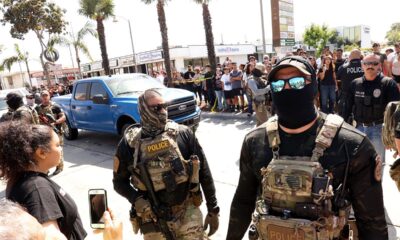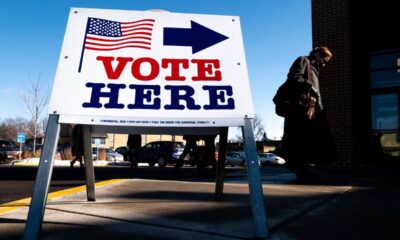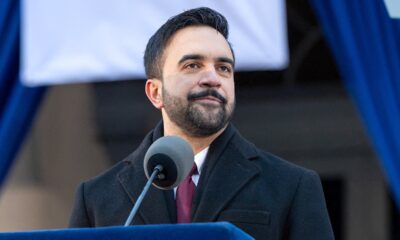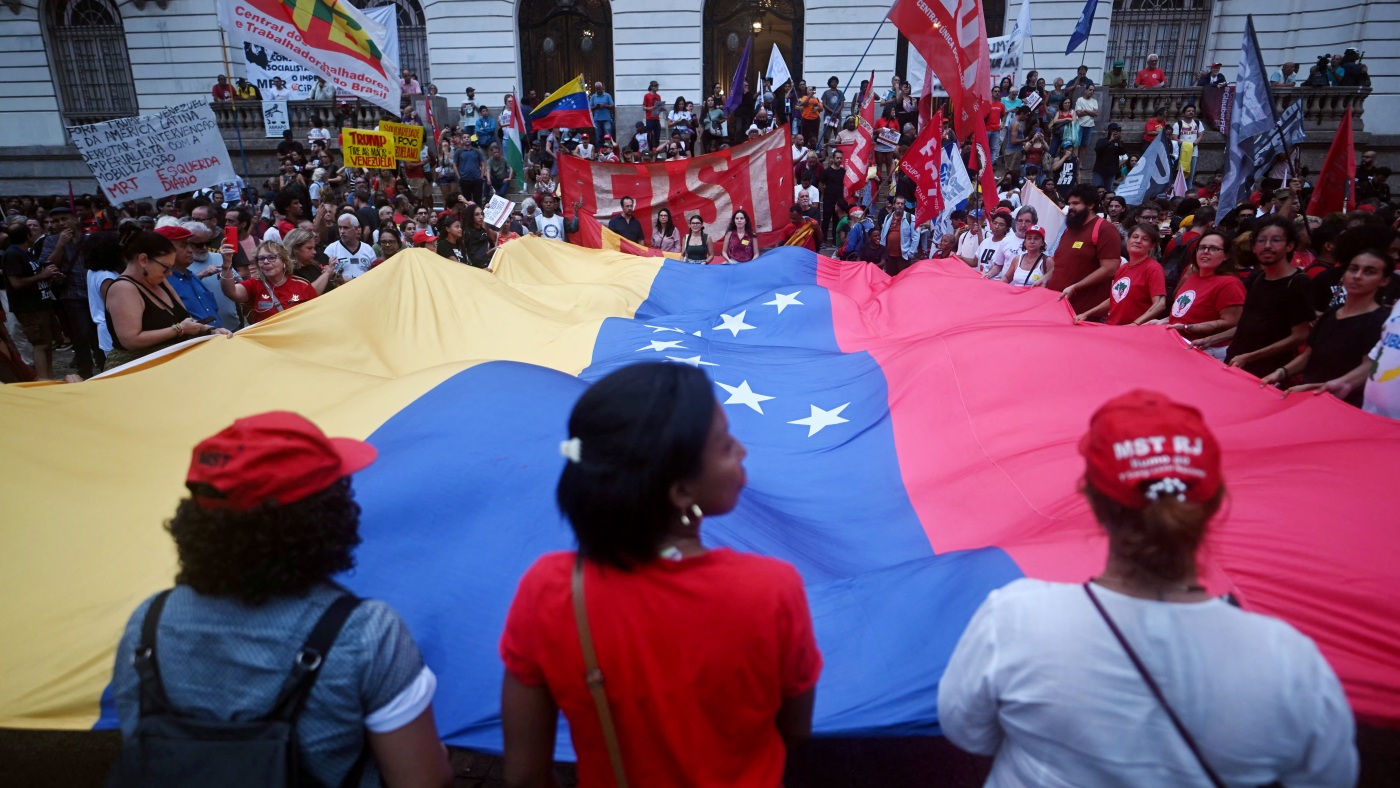New York
Read Judge Dale Ho’s Ruling in the Eric Adams Corruption Case

Case 1:24-cr-00556-DEH Document 177 Filed 04/02/25
Page 40 of 78
of the leave-of-court requirement in Rule 48(a) is to enable a court to inquire into whether the
dismissal should be with prejudice”).
The Second Circuit has thus far declined to “rule out discretionary dismissals with
prejudice” in similar contexts. Hilbert v. Dooling, 476 F.2d 355, 361 (2d Cir. 1973); see also id.
at 363 (Friendly, C.J., dissenting) (stressing “the district judge’s discretion” under Rule 48(b) “to
dismiss either with or without prejudice as he deemed appropriate”). But the “Circuit has not
specifically addressed” under what circumstances, if any, a court may dismiss an indictment with
prejudice notwithstanding the government’s request that dismissal be without prejudice. United
States v. Hernandez-Hernandez, No. 18 Crim. 30, 2018 WL 4765129, at *2 (W.D.N.Y. Sept. 13,
2018), report and recommendation adopted, 2018 WL 4762255 (W.D.N.Y. Oct. 2, 2018).
In exercising their discretion to dismiss with prejudice under Rule 48(a), courts have
generally looked to the same principles that motivate the “leave of court” requirement. In district
courts for the District of Columbia, where Rule 48(a) is “routinely applied . . . to consider dismissal
with prejudice,” courts “take into account (1) the purpose of the government’s dismissal, (2) the
presence or absence of good faith, and (3) the objective effect that dismissal without prejudice
would have on the defendant.” United States v. Madzarac, 678 F. Supp. 3d 42, 48 (D.D.C. 2023).
Courts in this District have had less occasion to consider the question, but they have tended to look
to whether there is a risk of prosecutorial harassment from re-charging of the offense(s) or whether
there is evidence of bad faith on the part of the prosecution. See, e.g., Doody, 2002 WL 562644,
at *2 (explaining that “[c]ourts dismiss cases under Rule 48(a) with prejudice or deny such motions
19 (D.D.C. 2015); Poindexter, 719 F. Supp. at 10-12; United States v. Angilau, No. 08 Crim. 431,
2012 WL 346446, at *14 (D. Utah Feb. 1, 2012), aff’d in part, appeal dismissed in part, 717 F.3d
781 (10th Cir. 2013); United States v. Wecht, No. 06 Crim. 26, 2008 WL 65605, at *5-6 (W.D. Pa.
Jan. 4, 2008); Government of Virgin Islands ex rel. Robinson v. Schneider, 893 F. Supp. 490, 498
(D.V.I. 1995); United States v. Rossoff, 806 F. Supp. 200, 202-03 (C.D. Ill. 1992); United States
v. Fields, 475 F. Supp. 903, 904, 908 (D.D.C. 1979).
40

New York
Vote on the 17 Ways Mamdani Could Improve NYC

A new mayor, a fresh start — you know the drill. There are as many ideas out there for how Zohran Mamdani can now improve New York’s urban environment as there are New Yorkers.
I canvassed a few dozen planners, architects, academics, community leaders, neighborhood organizers, developers, housing and transit experts and former city government officials. I gave them no budgets or time lines. They gave me a mayoral to-do list of ideas big, small, familiar, deep in the weeds, fanciful and timely.
What follows is a small selection, with some kibitzing by me. You can vote “love it” or “skip it” below and help determine the ranking of priorities. Feel free to leave eye rolls and alternative proposals in the comments section.
Check back in the coming days to see how the ranking has changed and we will let you know the ultimate results on Jan. 13.
1
Create many thousands more affordable housing units by converting some of the city’s public golf courses into mixed income developments, with garden allotments and wetlands.
2
Deck over Robert Moses’s Cross Bronx Expressway and create a spectacular new park.
3
Devise a network of dedicated lanes for e-bikes and electric scooters so they will endanger fewer bicyclists and pedestrians.
4
Pedestrianize Lower Manhattan. Not even 10 percent of people there arrive by car.
5
Build more mental health crisis centers citywide.
6
Provide more clean, safe public pay toilets that don’t cost taxpayers $1 million apiece.
7
Convert more coastline into spongy marshes, akin to what exists at Hunter’s Point South Park in Queens, to mitigate rising seas and floods.
8
Dedicate more of the city budget to public libraries and parks, the lifeblood of many neighborhoods, crucial to public health and climate resilience. The city devotes barely 2 percent of its funds to them now.
9
Follow through on the Adams administration’s $400 million makeover of once-glamorous Fifth Avenue from Central Park South to Bryant Park, with wider sidewalks, reduced lanes of traffic, and more trees, restaurants, bikes and pedestrian-friendly stretches.
10
Do away with free street parking and enforce parking placard rules. New York’s curbside real estate is priceless public land, and only a small fraction of residents own cars.
11
Open the soaring vaults under the Brooklyn Bridge to create shops, restaurants, a farmers’ market and public library in nascent Gotham Park.
13
Persuade Google, JPMorgan or some other city-vested megacorporation to help improve the acoustics as well as Wi-Fi in subways, along the lines of Citibank sponsoring Citi Bikes.
14
Overhaul freight deliveries to get more 18-wheelers off city streets, free up traffic, reduce noise, improve public safety and streamline supply chains.
15
Rein in City Hall bureaucracy around new construction. The city’s Department of Design and Construction is full of good people but a longtime hot mess at completing public projects.
16
Convert more streets and intersections into public plazas and pocket parks. Like the pedestrianization of parts of Broadway, this Bloomberg-era initiative has proved to be good for businesses and neighborhoods.
17
Stop playing Russian roulette with a crumbling highway and repair the Brooklyn-Queens Expressway before it collapses.
New York
Congestion pricing after one year: How life has changed.

“There’s less traffic and more parking.”
“I only drive if I have to move something large or heavy.”
“Sometimes I skip lunch at work to make up for the driving tax.” “I visit my elderly parents less often.”
“I complain to myself every time I have to pay the fee and I’m STILL 100% in favor of it.”
“I am returning my leased car six months before the lease expires.”
One year after the start of congestion pricing, traffic jams are less severe, streets are safer, and commute times are improving for travelers from well beyond Manhattan. Though these changes aren’t noticeable to many, and others feel the tolls are a financial burden, the fees have generated hundreds of millions of dollars for public transportation projects. And it has probably contributed to rising transit ridership.
The program, which on Jan. 5, 2025, began charging most drivers $9 during peak travel times to enter Manhattan below 60th Street, has quickly left its mark.
To assess its impact, The New York Times reviewed city and state data, outside research, and the feedback of more than 600 readers with vastly different views of the toll.
Some groused about high travel costs. Others cheered for a higher toll. Many shared snapshots from their lives: quieter streets, easier parking, costlier trips to the doctor.
Many findings from a Times analysis a few months into the experiment have held up. The program so far has met nearly all of the Metropolitan Transportation Authority’s goals, although more evidence is needed on some measures. And one question remains unresolved: whether a federal judge will decisively shield the program from efforts by the Trump administration to end it.
“Despite the threats to shut it down,” Gov. Kathy Hochul said in an interview, “the cameras are still on, and business is still up, and traffic is still down. So it’s working.”
Here’s the evidence one year in:
1. Fewer vehicles
About 73,000 fewer vehicles are entering the central business district each day, a number that has added up in the first year to about 27 million fewer entries. The decline, compared with traffic trends before the toll, has been remarkably stable across the year:
Average daily entries to the central business district
All other consequences of congestion pricing flow from this one — that fewer people are choosing to enter the area by private vehicle.
“I never drive into the city anymore. I only take the subway. It’s a relief.”
Philip Zalon Brooklyn
“I’m much more aware of driving into Manhattan and avoid it unless I have to haul a lot of stuff like a car load of Girl Scout cookies.”
Jacob White Queens
By influencing that one decision, the policy can also affect commute times, transit reliability, road safety, street life and more (as we’ll get to below).
One clear sign that behaviors are changing: Every weekday, there is now a spike in vehicles entering the zone right before the toll kicks up to $9 at 5 a.m., and right after it declines to $2.25 at 9 p.m.
Personal vehicle entries into the central business district
“I’ve decided to get up earlier to get the lower price.”
Eric Nehs Manhattan
“It is exhausting to plan the trip to cross the line at 9 p.m.”
Paul S. Morrill Manhattan
2. Faster traffic
The first consequence of those fewer vehicles is that traffic is now moving faster for the drivers who remain, and for the buses that travel those same roads. And this turns out to be true inside the congestion zone, near the congestion zone, and even much farther away.
Change in vehicle speeds, 2024-25
“Taking my kid to [doctor’s] visits in 2024 was a nightmare, every time. … After congestion pricing, it’s been noticeably less aggravating.”
Josh Hadro Brooklyn
Many readers, however, told us they didn’t believe they could see the benefits; the changes aren’t always easy to perceive by the naked eye. Readers also frequently said they believed the gains from congestion pricing were more apparent in the first months of the year and had waned since. The city’s speed data generally suggests that these improvements have been sustained, although some of the largest gains were recorded in the spring.
Average vehicle speeds in the congestion zone
But for some travelers, the speed gains have been much larger, particularly those who cross through the bridge and tunnel chokepoints into and out of Manhattan:
“Traffic approaching the [Holland] tunnel has saved me 15-30 minutes on the rides back to New York and given me hours of my time back.”
Salvatore Franchino Brooklyn
“On a typical 8 a.m. commute, there is so little traffic into the [Lincoln] tunnel that it looks like a weekend.”
Lisa Davenport Weehawken, N.J.
“I haven’t used the Lincoln Tunnel all year, probably will never use it again.”
Steven Lerner Manhattan
Improvements have also been more notable for commuters who take longer-distance trips ending in the congestion zone. That’s because those 73,000 vehicles a day that are no longer entering the zone have disappeared from surrounding roads and highways, too.
Commuters from farther out are seeing accumulating benefits from all these sources: faster speeds outside the congestion zone, much faster speeds through the tunnels and bridges, and then the improvements inside Manhattan. And people who travel roads outside the congestion zone without ever entering it get some of these benefits, too.
An analysis by researchers at Stanford, Yale and Google confirmed this through the program’s first six months. Using anonymized data from trips taken with Google Maps, they found that speeds improved after congestion pricing more on roads around the region commonly traveled by drivers heading into the central business district. That’s a subtle point, but one many readers observed themselves:
“Noticeably fewer cars driving, even way out in Bensonhurst!”
Charles Haeussler Brooklyn
“Even across the river in Bergen County, I feel that we benefit.”
Michelle Carvell Englewood Cliffs, N.J.
“I supercommute weekly from Kingston by bus. Each week, my bus round trip is 30-60 minutes faster than it was before congestion pricing.”
Rob Bellinger Kingston, N.Y.
3. More transit riders
Public transit will benefit from congestion pricing as its proceeds are invested in infrastructure upgrades; in the first year, the toll is projected to raise about $550 million after accounting for expenses, $50 million more than the M.T.A. originally predicted. But transit also stands to benefit as bus speeds improve on decongested roads and as more commuters shift to transit.
On bus routes that cross through the congestion zone, speeds increased this year, in notable contrast to the rest of the city. These improvements follow years of declining bus speeds in the central business district coming out of the pandemic.
Local bus routes
Express bus routes
Change in bus speeds, 2024-2025
“The crosstown buses are faster than they used to be, even during peak commuting times.”
Marc Wieman Manhattan
“Have gratefully noticed that they’re more on-time.”
Sue Ann Todhunter Manhattan
“It has significantly improved my bus trips from N.J., cutting about 20 minutes of traffic each way.”
John Ruppert New Jersey
Paid transit ridership is up this year compared with 2024 across the subway, M.T.A. buses, Long Island Rail Road and Metro-North Railroad as transit has continued its recovery from pandemic declines. About 300,000 more people are riding the subway each day — far more than the 70,000 cars that have been taken off the road in the congestion zone. So while congestion pricing is probably contributing to rising transit ridership, it’s not the main driver of it.
All of these added transit riders do, however, help explain why congestion pricing has not dampened activity in the busiest parts of the city, as critics feared. People are still coming, just not necessarily by private car.
“I finally taught myself to use the subway. Between the tunnel toll, congestion pricing and parking, I’m saving an enormous amount of money, time and inconvenience.”
Daniel Ludwig Weehawken, N.J.
“It’s made using the bus for short trips a more appealing option.”
John Buckholz Brooklyn
In fact, overall visits to the business district aren’t down — they were up by about 2.4 percent over the previous year, according to the city’s Economic Development Corporation. And restaurant reservations on the platform OpenTable were up inside the zone as well, by the same amount as the increase citywide.
Tom Harris, the president of the Times Square Alliance, which represents 2,600 businesses, said he had initially received complaints from some businesses. But he was pleasantly surprised that they soon stopped.
“We’re thrilled we have not seen negative impacts to local businesses,” he said. “It seems like it has been absorbed.”
4. Better quality of life
These primary shifts — fewer cars, less congested roads, more transit riders — have in turn produced a number of other effects that might more broadly be thought of as changes to qualify of life. Readers described experiencing safer crosswalks, less stressful bike rides and what feels like cleaner air.
In city data, the number of complaints to 311 for vehicle noises like car honking has declined significantly inside the congestion zone, compared with the rest of Manhattan.
Change in vehicle noise complaints, 2024-25
“Sometimes it’s almost — dare I say it? — quiet.”
Daniel Scott Manhattan
“Midtown is so much quieter now.”
Melanie DuPuis Manhattan/Hudson Valley
“It turns out that mostly when people say ‘New York is noisy’ they really mean ‘cars are noisy.’”
Grant Louis Manhattan
And the perception that roads have gotten safer is also borne out by crash data. The number of people who were seriously injured in a car crash decreased citywide, but the improvement was more pronounced in the congestion relief zone.
Change in number of people seriously injured in a crash, 2024-25
“Nobody’s trying to run me over.”
Alice Baruch Manhattan
“Fewer cars honking, fewer cars running red lights, fewer cars blocking crosswalks.”
Charlie Rokosny Brooklyn
“The number of blocked crosswalks have gone down significantly!”
Samir Lavingia Manhattan
Amid these positive changes, however, other readers described distinct declines in their quality of life, often stemming from the cost of the toll. These deeply personal observations have no corresponding measures in public data. But they make clear that some of those 27 million fewer driving trips weren’t simply replaced by transit or forgone as unnecessary — they’re missed.
“Sadly Manhattan is no longer an option for many things we once enjoyed.”
Linda Fisher Queens
“Congestion pricing has made my world much smaller.”
Justine Cuccia Manhattan
“I’m more careful about choosing events to attend, so I go to fewer of them.”
Karen Hoppe Queens
“I will not use doctors in Manhattan, limiting my health care choices.”
David Pecoraro Queens
One final aim of congestion pricing — improved air quality — has the potential to benefit everyone in the region. But the data remains inconclusive so far. A recent study from researchers at Cornell found a 22 percent improvement in one air quality measure over six months. But another analysis, by the Stanford and Yale authors, found little to no effect on air quality using local community sensors and comparing New York with other cities. And the M.T.A.’s own analysis of the program’s first year found no significant change in measured concentrations of vehicle-related air pollutants.
That doesn’t mean benefits won’t become clearer with more time and data. But the open questions about air quality underscore that even one year in, even with all the evidence gathered, there are still some effects we don’t fully understand.
“As an asthmatic, I can also palpably feel improvements in the air quality.”
Rob Hult Brooklyn
“It’s allowed me to believe that perhaps America can change for the better.”
Hanna Horvath Brooklyn
“As a car owner myself, I think it’s fair that the cost of driving is now being passed from city residents onto the drivers.”
Vincent Lee The Bronx
“I don’t like the cost but I also can’t deny its effectiveness.”
Jon Keese Queens
New York
Read the Indictment Against Nicolás Maduro

intentionally and knowingly combined, conspired, confederated, and agreed together and with each other to violate Title 18, United States Code, Section 924(c).
35. It was a part and an object of the conspiracy that NICOLÁS MADURO MOROS, DIOSDADO CABELLO RONDÓN, RAMÓN RODRÍGUEZ CHACÍN, CILIA ADELA FLORES DE MADURO, NICOLÁS ERNESTO MADURO GUERRA, a/k/a “Nicolasito,” a/k/a “The Prince,” and HECTOR RUSTHENFORD GUERRERO FLORES, a/k/a “Niño Guerrero,” the defendants, and others known and unknown, during and in relation to a drug trafficking crime for which they may be prosecuted in a court of the United States, to wit, for MADURO MOROS, CABELLO RONDÓN, and RODRÍGUEZ CHACÍN, the controlled substance offenses charged in Counts One and Two of this Superseding Indictment, and for FLORES DE MADURO, MADURO GUERRA, and GUERRERO FLORES, the controlled substance offense charged in Count Two of this Superseding Indictment, knowingly used and carried firearms, and, in furtherance of such crimes, knowingly possessed firearms, and aided and abetted the use, carrying, and possession of firearms, to wit, machineguns that were capable of automatically shooting more than one shot, without manual reloading, by a single function of the trigger, as well as destructive devices, in violation of Title 18, United States Code, Sections 924(c)(1)(A) and 924(c)(1)(B)(ii). (Title 18, United States Code, Sections 924(o) and 3238.)
36.
FORFEITURE ALLEGATIONS
As a result of committing the controlled substance offense charged in Count One of this Superseding Indictment, NICOLÁS MADURO MOROS, DIOSDADO CABELLO RONDÓN, RAMÓN RODRÍGUEZ CHACÍN, the defendants, shall forfeit to the United States, pursuant to Title 21, United States Code, Sections 853 and 970, any and all property constituting, or derived from, any proceeds the defendants obtained, directly or indirectly, as a result of the offenses, and any and all property used, or intended to be used, in any manner or part, to commit,
23
25
-

 World1 week ago
World1 week agoHamas builds new terror regime in Gaza, recruiting teens amid problematic election
-

 News1 week ago
News1 week agoFor those who help the poor, 2025 goes down as a year of chaos
-

 Business1 week ago
Business1 week agoInstacart ends AI pricing test that charged shoppers different prices for the same items
-

 World1 week ago
World1 week agoPodcast: The 2025 EU-US relationship explained simply
-

 Business1 week ago
Business1 week agoApple, Google and others tell some foreign employees to avoid traveling out of the country
-

 Technology1 week ago
Technology1 week agoChatGPT’s GPT-5.2 is here, and it feels rushed
-

 Health1 week ago
Health1 week agoDid holiday stress wreak havoc on your gut? Doctors say 6 simple tips can help
-

 Politics1 week ago
Politics1 week ago‘Unlucky’ Honduran woman arrested after allegedly running red light and crashing into ICE vehicle

























